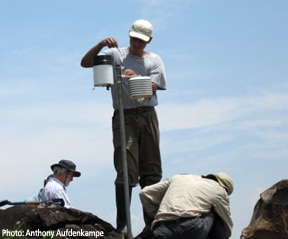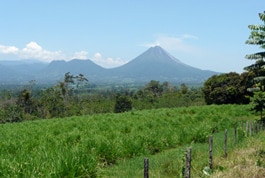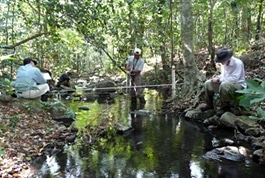
Stroud Water Research Center scientists posit that the naturally occurring differences in temperature, rainfall, and the hydrological characteristics of tropical landscapes will yield useful information about how climate variation and change may impact the diverse species that populate our planet, and teach us more about climate feedbacks to carbon cycling processes. To research that hypothesis, they went to Costa Rica.
As part of a long-term research project funded by the National Science Foundation, the Stroud Center has been recording daily, monthly, seasonal, annual — and even multiyear data — from which it expects to gain insights on both natural and human induced climate change. Recording the water chemistry, hydrological and meteorological data, soil characteristics, and macroinvertebrate population patterns, will provide the ecological observations and a climatic template that will help us to create a scalable model of what we might expect as our climate changes.
“We’re looking at the greatest climatic swing seen in decades, one not seen since 1975,” says John Jackson, one of the Stroud Center’s scientists who has been working on this project since its inception in 2005, “and this provides us with unique opportunities for research.” If, as expected, we transition from El Niño to La Niña this summer, experts have predicted an “active to extremely active” hurricane season.”
The result, says Jackson, is the potential for a staggering, 8-fold increase in storms — up from three the year prior, to potentially as many as 23 — thirty-percent of which could pack winds of 111 mph or higher. The model Center scientists hope to establish as a result of this research, will provide a useful tool to forecast the results of these kinds of extreme weather patterns, allowing us to better prepare for, and possibly avert, ecological and human disasters.
Tropical Microclimates May Provide the Key

Maritza Biological Station, the field station in Costa Rica from which the Stroud Center conducts many of its Central and South American studies, is an ideal place to study tropical stream ecology and how it differs with climatic variation. For 22 years, the Rio Tempisquito and its tributaries have been the subject of research by Stroud Center scientists. Recently, however, this study in Costa Rica was expanded to encompass the other streams and rivers that surround the perimeter of the Orosí Volcano which exhibit wholly different ecosystems.
When most of us think of the tropics we think of hot, rainy and lush jungle. The reality is actually quite different and boasts a varied landscape and microclimates, as Stroud Center scientists have discovered. The permanent and ephemeral inland waters of the tropics are subject to weather patterns that are driven solely by their placement within the mountain geography; they endure climatic cycles like the warmer and dryer El Niño and the cooler and wetter La Niña, and have vast differences in the nature of their forest cover (evergreen or deciduous) as well.

The result is that one can find a true rainforest on the Atlantic side, and an area on the Pacific that experiences a four to six-month dry season. A mere 12 kilometers away, yet another location will receive half the rainfall of its neighbor. In fact, annual rainfall can vary from one to five meters per year within a very small geographic sphere. The proximity of these different sites and the extreme variability between them makes this area of Costa Rica an ideal laboratory to study the impact of these differences on tropical biodiversity and stream ecology — and it may provide the key to gaining essential insights about climate feedbacks to carbon cycling processes, something that could have an impact on all of us.
Read more about the long-term Costa Rica research project.



